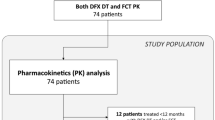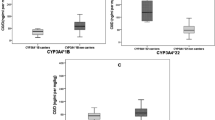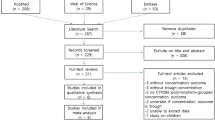Abstract
Deferasirox (DFX) is the only once-daily oral chelator for iron overload and its pharmacokinetic has been related with response to therapy. Our aim was to evaluate DFX plasma concentrations according to single-nucleotide polymorphisms in genes involved in its metabolism (UGT1A1, UGT1A3, CYP1A1, CYP1A2 and CYP2D6) and elimination (MRP2 and BCRP1). Further aim was to define a plasma concentration cutoff value predicting an adequate response to therapy. Plasma concentrations were determined at the end of dosing interval (Ctrough) using an high-performance liquid chromatography–ultraviolet method. Allelic discrimination was performed by real-time PCR. Ctrough levels were influenced by UGT1A1C>T rs887829, CYP1A1C>A rs2606345, CYP1A2A>C rs762551, CYP1A2C>T rs2470890 and MRP2G>A rs2273697 polymorphisms. A DFX plasma efficacy cutoff value of 20 000 ng ml−1 was identified; CYP1A1C>A rs2606345 AA and CYP1A2C>T rs2470890 TT genotypes may predict this value, suggesting a negative predictive role in therapy efficacy. Our data suggest the feasibility of a pharmacogenetic-based DFX dose personalization.
This is a preview of subscription content, access via your institution
Access options
Subscribe to this journal
Receive 6 print issues and online access
$259.00 per year
only $43.17 per issue
Buy this article
- Purchase on Springer Link
- Instant access to full article PDF
Prices may be subject to local taxes which are calculated during checkout







Similar content being viewed by others
References
Cappellini MD, Cohen A, Piga A, Bejaoui M, Perrotta S, Agaoglu L et al. A phase 3 study of deferasirox (ICL670), a once-daily oral iron chelator, in patients with beta-thalassemia. Blood 2006; 107: 3455–3462.
Nisbet-Brown E, Olivieri NF, Giardina PJ, Grady RW, Neufeld EJ, Sechaud R et al. Effectiveness and safety of ICL670 in iron-loaded patients with thalassaemia: a randomised, double-blind, placebo-controlled, dose-escalation trial. Lancet 2003; 361: 1597–1602.
Waldmeier F, Bruin GJ, Glaenzel U, Hazell K, Sechaud R, Warrington S et al. Pharmacokinetics, metabolism, and disposition of deferasirox in beta-thalassemic patients with transfusion-dependent iron overload who are at pharmacokinetic steady state. Drug Metab Dispos 2010; 38: 808–816.
Bruin GJ, Faller T, Wiegand H, Schweitzer A, Nick H, Schneider J et al. Pharmacokinetics, distribution, metabolism, and excretion of deferasirox and its iron complex in rats. Drug Metab Dispos 2008; 36: 2523–2538.
Taher A, Hershko C, Cappellini MD . Iron overload in thalassaemia intermedia: reassessment of iron chelation strategies. Br J Haematol 2009; 147: 634–640.
Chirnomas D, Smith AL, Braunstein J, Finkelstein Y, Pereira L, Bergmann AK et al. Deferasirox pharmacokinetics in patients with adequate versus inadequate response. Blood 2009; 114: 4009–4013.
Cappellini M, Giardina P, Porter J . Long-term safety and tolerability of the once-daily, oral iron chelator deferasirox (Exjade®, ICL670) in patients with transfusional iron overload. Blood 2006; 108: 501a.
EPAR E. Exjade (deferasirox) Prescribing Information. Novartis Pharmaceuticals Corporation: East Hanover, NJ, 2007.
Bennett W, Ponticelli C, Piga A . Summanry of long-term renal safety data in transfused patients with secondary iron overload receiving deferasirox (ExjadeR, ICL670). Blood 2006; 108: 30b.
Cappellini MD . Exjade(R) (deferasirox, ICL670) in the treatment of chronic iron overload associated with blood transfusion. Ther Clin Risk Manag 2007; 3: 291–299.
Galanello R, Piga A, Alberti D, Rouan MC, Bigler H, Sechaud R . Safety, tolerability, and pharmacokinetics of ICL670, a new orally active iron-chelating agent in patients with transfusion-dependent iron overload due to beta-thalassemia. J Clin Pharmacol 2003; 43: 565–572.
Hershko C, Konijn AM, Nick HP, Breuer W, Cabantchik ZI, Link G . ICL670A: a new synthetic oral chelator: evaluation in hypertransfused rats with selective radioiron probes of hepatocellular and reticuloendothelial iron stores and in iron-loaded rat heart cells in culture. Blood 2001; 97: 1115–1122.
Nick H, Acklin P, Lattmann R, Buehlmayer P, Hauffe S, Schupp J et al. Development of tridentate iron chelators: from desferrithiocin to ICL670. Curr Med Chem 2003; 10: 1065–1076.
Mao Q, Unadkat JD . Role of the breast cancer resistance protein (ABCG2) in drug transport. AAPS J 2005; 7: E118–E133.
Iyer L, Das S, Janisch L, Wen M, Ramirez J, Karrison T et al. UGT1A1*28 polymorphism as a determinant of irinotecan disposition and toxicity. Pharmacogenomics J 2002; 2: 43–47.
De Francia S, Massano D, Piccione FM, Pirro E, Racca S, Di Carlo F et al. A new HPLC UV validated method for therapeutic monitoring of deferasirox in thalassaemic patients. J Chromatogr B Analyt Technol Biomed Life Sci 2012; 893–894: 127–133.
Lee JW, Kang HJ, Choi JY, Kim NH, Jang MK, Yeo CW et al. Pharmacogenetic study of deferasirox, an iron chelating agent. PLoS ONE 2013; 8: e64114.
Novartis Pharmaceuticals. Exjade (deferasirox) Tablets for Oral Suspension (Prescribing Information). Novartis Pharmaceuticals: East Hanover (NJ), 2006.
Brittenham GM, Badman DG . Noninvasive measurement of iron: report of an NIDDK workshop. Blood 2003; 101: 15–19.
Jensen PD . Evaluation of iron overload. Br J Haematol 2004; 124: 697–711.
Galanello R, Piga A, Forni GL, Bertrand Y, Foschini ML, Bordone E et al. Phase II clinical evaluation of deferasirox, a once-daily oral chelating agent, in pediatric patients with beta-thalassemia major. Haematologica 2006; 91: 1343–1351.
Chaudhary P, Pullarkat V . Deferasirox: appraisal of safety and efficacy in long-term therapy. J Blood Med 4: 101–110.
Lai YR, Liu RR, Li CF, Huang SL, Li Q, Habr D et al. Efficacy of Deferasirox for the treatment of iron overload in Chinese thalassaemia major patients: results from a prospective, open-label, multicentre clinical trial. Transfus Med 2013; 23: 389–396.
Naderi M, Sadeghi-Bojd S, Valeshabad AK, Jahantigh A, Alizadeh S, Dorgalaleh A et al. A prospective study of tubular dysfunction in pediatric patients with Beta thalassemia major receiving deferasirox. Pediatr Hematol Oncol 2013; 30: 748–754.
Galanello R, Origa R . Beta-thalassemia. Orphanet J Rare Dis 2010; 5: 11.
Cunningham MJ, Macklin EA, Neufeld EJ, Cohen AR . Complications of beta-thalassemia major in North America. Blood 2004; 104: 34–39.
Pennell DJ, Berdoukas V, Karagiorga M, Ladis V, Piga A, Aessopos A et al. Randomized controlled trial of deferiprone or deferoxamine in beta-thalassemia major patients with asymptomatic myocardial siderosis. Blood 2006; 107: 3738–3744.
Taher A, Sheikh-Taha M, Sharara A, Inati A, Koussa S, Ellis G et al. Safety and effectiveness of 100 mg/kg/day deferiprone in patients with thalassemia major: a two-year study. Acta Haematol 2005; 114: 146–149.
Neufeld EJ . Oral chelators deferasirox and deferiprone for transfusional iron overload in thalassemia major: new data, new questions. Blood 2006; 107: 3436–3441.
Sheth S . Iron chelation: an update. Curr Opin Hematol 2014; 21: 179–185.
Daar S, Pathare A, Nick H, Kriemler-Krahn U, Hmissi A, Habr D et al. Reduction in labile plasma iron during treatment with deferasirox, a once-daily oral iron chelator, in heavily iron-overloaded patients with beta-thalassaemia. Eur J Haematol 2009; 82: 454–457.
Schulz C, Heinemann V, Schalhorn A, Moosmann N, Zwingers T, Boeck S et al. UGT1A1 gene polymorphism: impact on toxicity and efficacy of irinotecan-based regimens in metastatic colorectal cancer. World J Gastroenterol 2009; 15: 5058–5066.
Kang TW, Kim HJ, Ju H, Kim JH, Jeon YJ, Lee HC et al. Genome-wide association of serum bilirubin levels in Korean population. Hum Mol Genet 19: 3672–3678.
Johnson AD, Kavousi M, Smith AV, Chen MH, Dehghan A, Aspelund T et al. Genome-wide association meta-analysis for total serum bilirubin levels. Hum Mol Genet 2009; 18: 2700–2710.
Sanna S, Busonero F, Maschio A, McArdle PF, Usala G, Dei M et al. Common variants in the SLCO1B3 locus are associated with bilirubin levels and unconjugated hyperbilirubinemia. Hum Mol Genet 2009; 18: 2711–2718.
Rotunno M, Yu K, Lubin JH, Consonni D, Pesatori AC, Goldstein AM et al. Phase I metabolic genes and risk of lung cancer: multiple polymorphisms and mRNA expression. PLoS One 2009; 4: e5652.
Wang S, Chanock S, Tang D, Li Z, Jedrychowski W, Perera FP . Assessment of interactions between PAH exposure and genetic polymorphisms on PAH-DNA adducts in African American, Dominican, and Caucasian mothers and newborns. Cancer Epidemiol Biomarkers Prev 2008; 17: 405–413.
Grover S, Talwar P, Gourie-Devi M, Gupta M, Bala K, Sharma S et al. Genetic polymorphisms in sex hormone metabolizing genes and drug response in women with epilepsy. Pharmacogenomics 11: 1525–1534.
Singh AP, Pant MC, Ruwali M, Shah PP, Prasad R, Mathur N et al. Polymorphism in cytochrome P450 1A2 and their interaction with risk factors in determining risk of squamous cell lung carcinoma in men. Cancer Biomark 8: 351–359.
B'Chir F, Pavanello S, Knani J, Boughattas S, Arnaud MJ, Saguem S . CYP1A2 genetic polymorphisms and adenocarcinoma lung cancer risk in the Tunisian population. Life Sci 2009; 84: 779–784.
Nakajima M, Yokoi T, Mizutani M, Kinoshita M, Funayama M, Kamataki T . Genetic polymorphism in the 5'-flanking region of human CYP1A2 gene: effect on the CYP1A2 inducibility in humans. J Biochem 1999; 125: 803–808.
Sachse C, Bhambra U, Smith G, Lightfoot TJ, Barrett JH, Scollay J et al. Polymorphisms in the cytochrome P450 CYP1A2 gene (CYP1A2) in colorectal cancer patients and controls: allele frequencies, linkage disequilibrium and influence on caffeine metabolism. Br J Clin Pharmacol 2003; 55: 68–76.
Luna-Tortos C, Fedrowitz M, Loscher W . Evaluation of transport of common antiepileptic drugs by human multidrug resistance-associated proteins (MRP1, 2 and 5) that are overexpressed in pharmacoresistant epilepsy. Neuropharmacology 58: 1019–1032.
Catterall WA . Molecular properties of brain sodium channels: an important target for anticonvulsant drugs. Adv Neurol 1999; 79: 441–456.
Lipkind GM, Fozzard HA . Molecular model of anticonvulsant drug binding to the voltage-gated sodium channel inner pore. Mol Pharmacol 78: 631–638.
Koopmann TT, Bezzina CR, Wilde AA . Voltage-gated sodium channels: action players with many faces. Ann Med 2006; 38: 472–482.
Meisler MH, O’Brien JE, Sharkey LM . Sodium channel gene family: epilepsy mutations, gene interactions and modifier effects. J Physiol 588 (Pt 11) 1841-1848.
Popat RA, Van Den Eeden SK, Tanner CM, Kamel F, Umbach DM, Marder K et al. Coffee, ADORA2A, and CYP1A2: the caffeine connection in Parkinson’s disease. Eur J Neurol 2011; 18: 756–765.
Tiwari AK, Deshpande SN, Lerer B, Nimgaonkar VL, Thelma BK . Genetic susceptibility to Tardive Dyskinesia in chronic schizophrenia subjects: V. Association of CYP1A2 1545 C>T polymorphism. Pharmacogenomics J 2007; 7: 305–311.
Grover S, Kukreti R . A systematic review and meta-analysis of the role of ABCC2 variants on drug response in patients with epilepsy. Epilepsia 54: 936–945.
Engstrom K, Ameer S, Bernaudat L, Drasch G, Baeuml J, Skerfving S et al. Polymorphisms in genes encoding potential mercury transporters and urine mercury concentrations in populations exposed to mercury vapor from gold mining. Environ Health Perspect 121: 85–91.
Gonzalez de Requena D, Calcagno A, Bonora S, Ladetto L, D'Avolio A, Sciandra M et al. Unexpected drug-drug interaction between tipranavir/ritonavir and enfuvirtide. AIDS 2006; 20: 1977–1979.
Canta F, Marrone R, Bonora S, D'Avolio A, Sciandra M, Sinicco A et al. Pharmacokinetics and hepatotoxicity of lopinavir/ritonavir in non-cirrhotic HIV and hepatitis C virus (HCV) co-infected patients. J Antimicrob Chemother 2005; 55: 280–281.
Chen G, Ramos E, Adeyemo A, Shriner D, Zhou J, Doumatey AP et al. UGT1A1 is a major locus influencing bilirubin levels in African Americans. Eur J Hum Genet 2012; 20: 463–468.
Grover S, Kukreti R . A systematic review and meta-analysis of the role of ABCC2 variants on drug response in patients with epilepsy. Epilepsia 2013; 54: 936–945.
Grover S, Talwar P, Gourie-Devi M, Gupta M, Bala K, Sharma S et al. Genetic polymorphisms in sex hormone metabolizing genes and drug response in women with epilepsy. Pharmacogenomics 2010; 11: 1525–1534.
Lin KM, Tsou HH, Tsai IJ, Hsiao MC, Hsiao CF, Liu CY et al. CYP1A2 genetic polymorphisms are associated with treatment response to the antidepressant paroxetine. Pharmacogenomics 2010; 11: 1535–1543.
Author information
Authors and Affiliations
Corresponding author
Ethics declarations
Competing interests
The authors declare no conflict of interest.
Rights and permissions
About this article
Cite this article
Cusato, J., Allegra, S., Massano, D. et al. Influence of single-nucleotide polymorphisms on deferasirox Ctrough levels and effectiveness. Pharmacogenomics J 15, 263–271 (2015). https://doi.org/10.1038/tpj.2014.65
Received:
Revised:
Accepted:
Published:
Issue Date:
DOI: https://doi.org/10.1038/tpj.2014.65
This article is cited by
-
Population pharmacokinetics of topiramate in Chinese children with epilepsy
European Journal of Clinical Pharmacology (2023)
-
ABCC2 c.-24 C>T single-nucleotide polymorphism was associated with the pharmacokinetic variability of deferasirox in Chinese subjects
European Journal of Clinical Pharmacology (2020)
-
The effect of vitamin D pathway genes and deferasirox pharmacogenetics on liver iron in thalassaemia major patients
The Pharmacogenomics Journal (2019)
-
Role of CYP24A1, VDR and GC gene polymorphisms on deferasirox pharmacokinetics and clinical outcomes
The Pharmacogenomics Journal (2018)
-
Deferasirox AUC efficacy cutoff and role of pharmacogenetics
European Journal of Clinical Pharmacology (2016)



